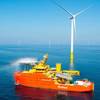CMMI, SPNM & ICS Focus on Container Weights
Three major maritime organizations, the Company of Master Mariners of India, the Institute of Chartered Shipbrokers and Shipping Professionals Network-Mumbai teamed up to focus on the recent International Maritime Organization’s (IMO) initiative on container weight verification. In this regard, a joint conference was held last weekend to deliberate on “Container Weights – Vagaries and Variances’ at the Maritime Training Institute of the Shipping Corporation of India’s auditorium, Powai, Mumbai.
The event saw a record number of participants from not just the shipping companies but also those into maritime training, exporters and importers, ship charterers, MTOs, freight forwarders, insurance firms, manning and ship management, logistics, et al. The issues relating to container weights gained significance especially after the Guidelines regarding the verified gross mass of a container carrying cargo were announced.
Various speakers underscored the importance of having the right container weight as it placed the ship, seafarers and workers ashore and the cargo at great risk. It is the shipper who is responsible for ensuring that the verified gross mass is communicated in the shipping document sufficiently in advance to be used by the ship’s master or his representative and the terminal representative in the preparation of the ship stowage plan. In the absence of the shipper providing the verified gross mass of the packed container, the container should not be loaded on to the ship
unless the master or his representative and the terminal representative have obtained the verified gross mass through other means.
It was noted that the Guidelines help to provide a common approach for the implementation and enforcement of the SOLAS requirements regarding the verification of the gross mass of packed containers. The Guidelines provide recommendations on how to interpret and apply the provisions of SOLAS requirements.
The important aspect viz. the “Unknown weights – Hazards faced by a Ship master” was amply illustrated by Capt Victor Dias of Anglo Eastern Ship Management Ltd. Through a pictorial presentation which brought into focus everal accidents that occurred as a result of wrong declaration of weight that led to improper stacking, also the draft marks exceeding, excessive stresses that come into play, effect on GM, damage to cargo gear and customs manifest getting mis-declared.
Another series of accidents highlighted by Capt Swaminathan Rajagopalan of MSC Agency (I) Pvt. Ltd who was explicitly in his presentation on what happens if the cargo is much more than what is declared. “Because of the mis-declaration a whole host of dangers come into play endangering lives of seafarers, cargo loss and the ensuing liability,” he said. He put into proper perspective of what is required for complying with the guidelines and what is needed for safe and secure sea transportation.
Capt Anil Singh, Managing Director, Subcontinent, DP World addressed the gathering on the terminal operators’ perspective. “Overloaded containers going abroad on vessels has gone unchecked for a long time,” he pointed out. “Not only the vessels and the cargoes, that are endangered, but worse still it is the seafarers who is at the receiving end.”
Wrapping up the deliberations of the above first session Capt S. Narula, Director of the Liner Division of SCI stated, “But declaring lesser weight need not necessarily be the problem, but also declaring a container to have more cargo than it is actually does. This too can be hazardous and can cause imbalance in stacking containers. The key is to verify the correct weight at the point of origin.”
In the second session Capt S.L. Karmarkar, Sr Surveyor of the Indian Register of Shipping who has been representing India’s interests at the IMO gave an in-depth explanation on what the guidelines were about and What IMO is doing about DSC 18 and MSC 93). The Annex to MSC 1/Cir. 1475 – ‘Guidelines regarding the verified Gross Mass of a Container Carrying Cargo’ was described in details giving special reference to the scope of applicability, method of obtaining verified gross mass, usage of equipment, documentation, transshipment, intermodal movements and host of other connected issues.
Providing the Shipper’s perspective Mr. N.M. Kumbhar, General Manager – Logistics, Bhushan Steel Ltd., noted there was not much resistance from the shippers, who were at the center of the whole rigmarole. He stated, “99% of the declared weight was correct because it was certified weight. However, do we have the necessary infrastructure in place and are we ready to adhere to this resolution by 2016?” He also questioned about the cost that will be involved and the additional time consuming procedure.
In the discussions cautious remarks were made about the whole exercise becoming into a kind of a blame game. One speaker went to the extent of saying “IMO is an octopus in the sea. But if IMO becomes a walking fish there is going to be trouble for all operators on the land.” It is better for the terminal operators to put more infrastructure in place to ensure the right weight is declared. Ultimately, all could follow the regulations but on the long run it is the shipper who will have to pay for the additional cost. Another speaker fumed "IMO had no business on land."
Capt Deepak Tewari, CEO of MSC Agency (India) Pvt. Ltd. who chaired the second session mentioned, “There are 130 million containers being carried by ships worldwide and the most of them being overweight. Thanks to the law coming into force. This malady exists today because the general public suffers from ‘Sea Blindness’.” He cautioned that in the final analysis it is the master of the vessel who will taking a strong stand and will refuse to take on board any container which is suspect. It will be the shipper who will have to bear the cost for that extra burden for detention and transportation.














